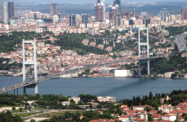Turkey’s second-quarter GDP growth, released by the central bank on September 11, surprised on the up side, with an 8.8% year-on-year (y-o-y) rise that easily surpassed the 6.4% expected by the market. Growth is down from the 11.6% posted in the first quarter, however, and a looming slowdown in the eurozone has many concerned about Turkey’s exposure.
Turkish fiscal and monetary policymakers will have a challenge on their hands as they attempt to sustain a boom in the face of a potential double-dip recession in the country’s biggest trading partner. Burgeoning domestic demand, low debt ratios that allow for fiscal stimulus, and access to non-Western markets will all be key to maintaining Turkey’s record economic growth.
The fastest growing sectors were construction (13.2%), trade (13%), transport and communication (11.7%), hotels and restaurants (8.3%), and manufacturing (8%). Of these, however, only hotels and restaurants grew on a quarter-on-quarter (q-o-q) basis, and total GDP grew only 1.3% q-o-q, compared with the 1.7% achieved in the first quarter.
Meanwhile, Turkey’s Purchasing Managers Index (PMI), a leading economic indicator which tracks purchasing, fell from 52.3 to 48.8 from July to August, the first contraction since April 2009. All of this comes amid worsening global economic news. In a September analysis, financial services firm UBS, cut its global GDP growth projections for 2012 to 3.3%, with the US at 2.2% and the eurozone at a weak 1%.
Domestic demand continues to drive the Turkish economy, with 28% y-o-y growth in private consumption responsible for 6.3 percentage points of GDP growth in the second quarter. This increase has been cited as a threat that may overheat the economy, leading many to call for Turkey’s central bank to raise interest rates. Now, with a slowdown likely, continued low rates may be what are necessary to keep the economy chugging along.
Embracing its unorthodox approach, the central bank has recently loosened reserve requirements, allowing banks to meet up to 10% of their requirements in dollars or euros. It is also expected to lower reserve requirement ratios to further expand credit. Such counter-cyclical measures are likely to bolster growth in the short term, although they carry a risk of asset inflation. Sustaining growth through a slowdown will require a careful balancing act from Turkey’s monetary policymakers.
A further component of Turkey’s economic health is the fiscal picture, where the government may have room for economic stimulus if the economy goes further south. Turkey’s debt-to-GDP ratio stood at 42% in 2010, well below most industrial countries, including Germany (with 82%), France (74%) and the US (62%). Moreover, Turkey achieved a budget surplus of TL2.1bn ($1.2bn) in the January-August period. A slowdown will pull down tax revenues and increase welfare spending in the second half of 2011, but forecasters still expect a deficit-to-GDP ratio around 2% for 2011.
The healthy budgetary outlook will allow Turkey to use fiscal policy as a counter-cyclical measure in the second half of 2011 and into 2012, especially given its pressing infrastructural needs. Turkey is in the midst of several large projects, including the Marmaray project, which will connect Istanbul’s European and Asian sides with an underwater tunnel, and the Ankara-Istanbul high-speed rail line. The government recently announced a massive project, worth up to $30bn, for a “Canal Istanbul,” providing an alternative shipping route to the Bosphorus for large container ships. The government could accelerate spending on these projects or announce new programmes as a form of fiscal stimulus.
Finally, the extent to which Turkey can pull off a “soft landing” depends on its exposure to Europe, the region expected to experience the most significant slowdown. The EU still accounts for a large portion of both Turkey’s imports (40% in 2011) and exports (48%). However, the 2008 crisis seems to have marked a turning point in Turkey’s dependence on exporting to Europe, as Europe’s share has come down from a stable pre-crisis average of around 56%.
In the meantime, the Middle Eastern share of Turkish exports has increased from 14% in 2007 to 19% in 2011, and exports to Asia have grown from 4.8% to 7.2%. A resumption of stability in Libya, where Turkish businesses have historically thrived, would further diversify Turkish foreign trade. Turkey would still suffer in the face of European stagnation, but it is finding alternate markets for its goods.
Turkey’s current boom appears to be driven by real growth – namely, a burgeoning middle class hungry for consumption – rather than a short-term bubble. Risks are still present, including an expanding current account deficit and a weak lira. Nonetheless, Turkey has the tools of both monetary and fiscal policy available to avert a genuine recession, which is borne out by a recent UBS forecast of 3% growth for 2012.

